#USS Bunker Hill (CV-17)
Text

Porte-avions USS Bunker Hill (CV-17) attaqué par l'aviation japonaise pendant le raid sur Rabaul – Bombardement de Rabaul – Guerre du Pacifique – Papouasie-Nouvelle-Guinée – 11 novembre 1943
Photographe : W. Eugene Smith
#WWII#guerre du pacifique#pacific war#bombardement de rabaul#bombing of rabaul#marine militaire#military navy#marine de guerre#navy#porte-avions#aircraft carrier#classe essex#essex-class#uss bunker hill (cv-17)#uss bunker hill#cv-17#w. eugene smith#rabaul#papouasie-nouvelle-guinée#papua new guinea#11/11/1943#11/1943#1943
103 notes
·
View notes
Text


USS Bunker Hill (CV-17) burning after being hit by Kamikaze suicide planes during the Okinawa operation, on May 11, 1945.
Note: on the left is most likely USS Wilkes-Barre (CL-103) is steaming nearby.
Naval History and Heritage Command: 80-G-K-5271, 80-G-K-5274
#USS Bunker Hill (CV-17)#USS Bunker Hill#Essex Class#aircraft carrier#May#1945#USS Wilkes-Barre (CL-103)#USS Wilkes-Barre#Cleveland Class#Lighter Cruiser#Cruiser#united states navy#us navy#navy#usn#u.s. navy#Okinawa#kamikaze#world war 2#world war ii#WWII#WW2#WWII History#history#military history#military#my post
142 notes
·
View notes
Text
1945年 - Kamikaze Attack on Bunker Hill.
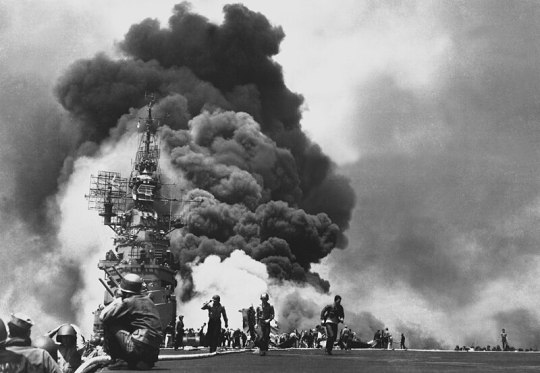


While covering the invasion of Okinawa, Bunker Hill (CV-17) was struck by two kamikazes in quick succession, setting the vessel on fire. Casualties exceeded 600, including 352 confirmed dead and an additional 41 missing, with 264 wounded.
0 notes
Photo

An SB2C runs up its engine on the deck of USS Bunker Hill (CV-17) during operations with Task Group 58.3, 16-17 February 1945
86 notes
·
View notes
Text
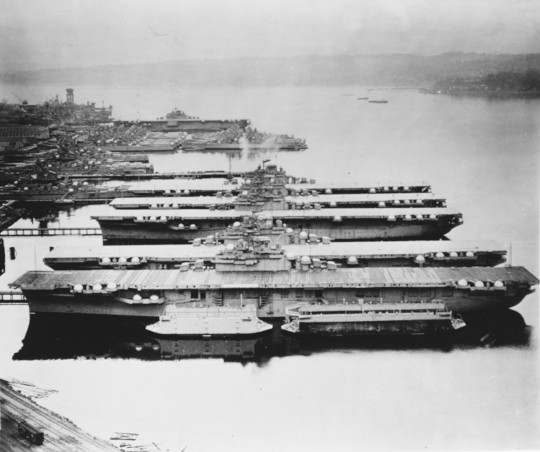
Ships of the Bremerton Group, U.S. Pacific Reserve Fleet, at Puget Sound Naval Shipyard, Washington (USA), circa on 23 April 1948.
There are six aircraft carriers visible (front to back): USS Essex (CV-9), USS Ticonderoga (CV-14), USS Yorktown (CV-10), USS Lexington (CV-16), USS Bunker Hill (CV-17), and USS Bon Homme Richard (CV-31) (in the background).
Three battleships and various cruisers are also visible.
19 notes
·
View notes
Photo

A near miss on the U.S. Navy aircraft carrier USS Bunker Hill (CV-17) during an attack by Japanese aircraft during the Battle of the Philippine Sea off the Marianas. 19 June 1944
37 notes
·
View notes
Video
F4U-1 Corsair by Willard Womack
Via Flickr:
A Corsair, from VF-17, catches a wire on board the aircraft carrier USS Bunker Hill CV-17 July, 11 1943.
7 notes
·
View notes
Photo

Mothballed Essex class carriers at Puget Sound Naval Shipyard in 1948. From front to rear USS Essex (CV-9), USS Ticonderoga (CV-14), USS Yorktown (CV-10), USS Lexington (CV-16), USS Bunker Hill (CV-17), USS Bon Homme Richard (CV-31)
0 notes
Photo
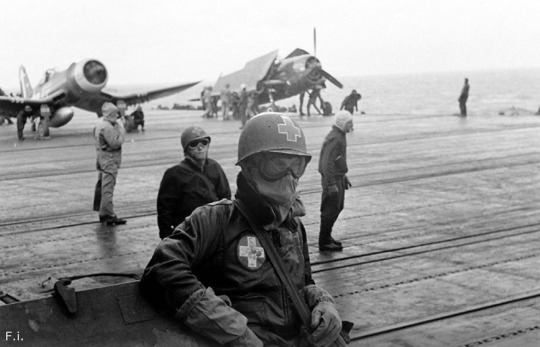
Medics on duty on the deck of the aircraft carrier USS Bunker Hill (CV-17) 1945
#army#aircraft#aviation#plane#history#World war#world war 2#WWII#navy#Ship#Fleet#aircraft carrier#USS Bunker Hill (CV-17)
243 notes
·
View notes
Text

-A Grumman E-1B Tracer of VAW-111 "Hunters" about to be launched from USS Bon Homme Richard (CVA-31) in 1968. | Photo: USN
FLIGHTLINE: 168 - GRUMMAN E-1 TRACER
Developed from the C-1 Trader COD airplane, the Tracer was the first purpose built airborne early warning (AEW) aircraft for the USN.
In February 1944 the US Navy ordered its first airborne early warning aircraft under Project CADILLAC. Based on research done at MIT in the early 1940s, the Cadillac radar, designated AN/APS-20, was fitted to a newly built TBM-3 Avenger. This XTBM-3W took its maiden flight on 5 August 1944 and was followed up by an emergency order for 27 additional conversion. Delivery of the TBM-3Ws began in March 1945, and the Navy anticipated four each of the aircraft deployed onto the carriers Enterprise, Hornet, and Bunker Hill in time for Operation OLYMPIC, the planned invasion of Kyushu. Ultimately, the use of atomic bombs on Hiroshima and Nagasaki cancelled Olympic, but the TBM-3Ws, nicknamed Guppy, continued to serve with the Navy into the 1950s.
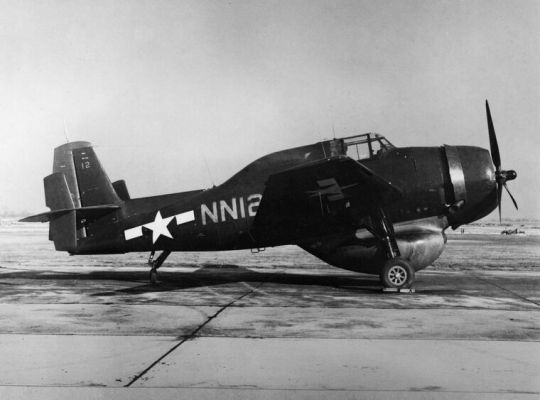
-A Guppy at the Naval Air Training Center, NAS Pax River, in 1946. | Photo: USN
AEW support for the Navy passed from the Guppy to variants of the A-1 Skyraider, Lockheed WV-2 and various blimps, but by the mid-1950s a new aircraft was desired. Grumman Aircraft offered a plane based on their C-1 Trader, itself based on the S-2 Tracker.
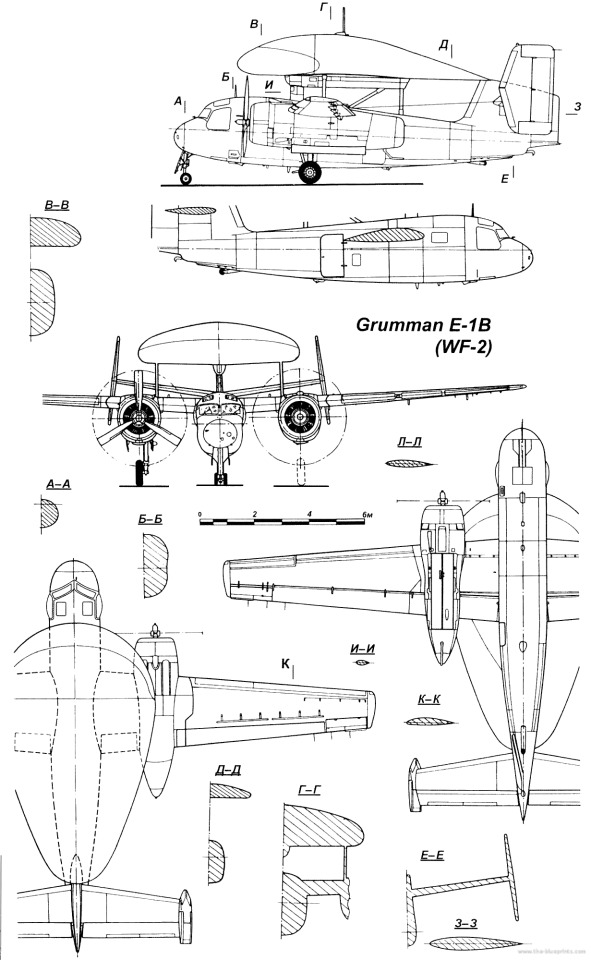
-Orthograph of the E-1 Tracer. | Illustration: Dr. Dan Saranga
One C-1, BuNo 136792, was pulled from the production line and modified with a new tail and mockup radome, but no electronics. The XTF-1W (later changed to XWF-1) took its first flight on 17 December 1956. After serving to validate the aerodynamic properties of the new aircraft's radome, -6792 was rebuilt as a standard C-1 (though it retained the modified tail) and served as a utility aircraft until 1983. The plane is now on display at the Quonset Air Museum in Rhode Island.
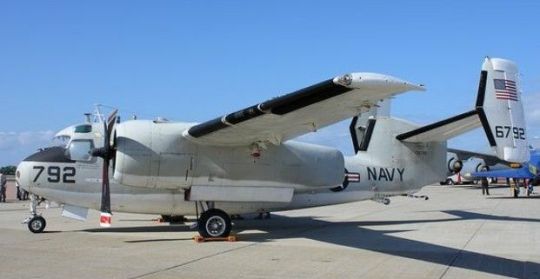
-792 after conversion to C-1A Trader. | Photo: USN
The production aircraft, designated WF-2, was 45ft long, and had a wingspan of 72ft. The wings were fitted with Grumman's Sto-Wing folding system, modified to fold the wing horizontally along the fuselage. The aircraft were powered by Wright R-1820-82A Cyclone piston engines, each developing 1,525hp at takeoff. The WF-2 had a cruise speed of 163mph and a max speed of 238mph, with range of 1,035mi and almost 7 hours endurance. Tracers were not aerial refuellable. The large radome, extending from the end of the cockpit to almost the rudder, contained a Hazeltine AN/APS-82 radar antenna, which incorporated an early Airborne Moving Target Indicator, which would differentiate an aircraft from surface clutter. Unlike the later E-2 Hawkeye, the Tracker's radome did not rotate, though the antenna did rotate within it. The standard crew of four was evenly split between the flight crew and radar/intercept controllers.

-An E-1B of VAW-121 "Griffins", operating from the USS FDR (CVA-42) in 1971. | Photo: USN
The WF-2 was accepted for Naval service in 1958, and was soon flying from carriers in both the Atlantic and Pacific. A total of 88 Trackers were produced. Although officially called 'Tracer', crews took to calling the aircraft 'Willy Fudd' (from its WF designation) or 'Stoof With A Roof' (the WF-2 was based on the S2F Tracker, hence 'Stoof', with the radome providing the 'Roof'). Under the 1962 tri-service designation reorganization, the WF-2 became the E-1B. Depending on the operating altitude, the APS-82 radar had a search range of 250-300 miles, and was capable of handling up to four simultaneous intercepts.

-An E-1B from VAW-11 "Early Eleven" unfolds its wings prior to being catapulted from the carrier USS Hancock (CVA-19) in 1962. | Photo: USN
WF-2s from VAW-12 "Bats" were deployed on USS-Essex, USS Randolph, USS Independence and the USS Enterprise during the 1961 Cuban Missile Crisis. The Willy Fudd saw extensive use early in the Vietnam War, providing vectors to MIG-CAP (MiG-combat air patrol) fighters, as well as controlling strikes over North Vietnam. Tracers also assisted during Search and Rescue (SAR) operations, as well as vectoring aircraft to tankers.
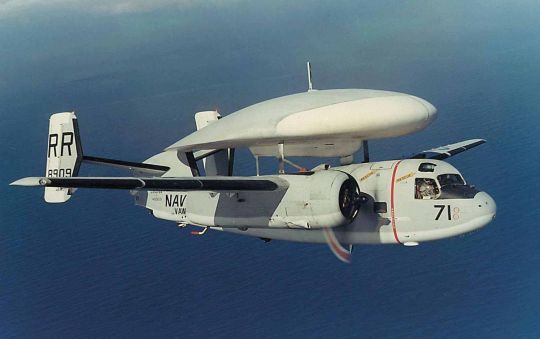
-An E-1B from VAW-11 "Early Eleven" in flight. | Photo: USN
Upgrades over the aircraft's lifespan increased their capacity and kept them current, but also added weight. Almost as soon as the E-1B entered service, the Navy began seeking a replacement, and Grumman was selected in 1957 to develop and build the new plane, initially designated the W2F-1, but was eventually christened the E-2 Hawkeye. Replacement of the Fudds began in 1966, but the war in Vietnam and the slow production of Hawkeyes saw the type remain in service until the early 70's. Up through 1973 E-1s were retired to Naval Reserve squadrons, and by 1977 the type was completely withdrawn from USN service. Five Tracers have been preserved in museums around the US:
E-1B, BuNo 147212: Intrepid Sea, Air & Space Museum, New York City
E-1B, BuNo 147217: New England Air Museum, Windsor Locks, Connecticut
E-1B, BuNo 147225: On board the USS Yorktown (CV-10), Patriots Point, Mount Pleasant, South Carolina
E-1B, BuNo 147227: Pima Air & Space Museum, adjacent to Davis-Monthan AFB in Tucson, Arizona
E-1B, BuNo 148146: National Naval Aviation Museum, Naval Air Station Pensacola
Another 11 E-1s are in storage at United Aeronautical's surplus yard just outside Tucson, though their status is unknown
#aircraft#aviation#avgeek#airplanes#cold war#airplane#cold war history#coldwar#aviation history#us navy#usn#grumman#grumman e1#e1b tracer#e 1b tracer#aew#airborne early warning
49 notes
·
View notes
Text
USS Bunker Hill (CV-17) on fire after being hit by two Kamikazes within 30 seconds.

"On the morning of May 11, 1945, while supporting the invasion of Okinawa, Bunker Hill was struck and severely damaged by two Japanese kamikaze planes. A Mitsubishi A6M Zero fighter plane piloted by Lieutenant Junior Grade Seizō Yasunori emerged from low cloud cover, dove toward the flight deck and dropped a 550-pound (250 kilogram) bomb that penetrated the flight deck and exited from the side of the ship at gallery deck level before exploding in the ocean. The Zero next crashed onto the carrier’s flight deck, destroying parked warplanes full of aviation fuel and ammunition, causing a large fire. The remains of the Zero went over the deck and dropped into the sea. Then, a short 30 seconds later, a second Zero, piloted by Ensign Kiyoshi Ogawa, plunged into its suicide dive. The Zero went through the antiaircraft fire, dropped a 550-pound bomb, and then crashed into the flight deck near the carrier’s “island”, as kamikazes were trained to aim for the island superstructure. The bomb penetrated the flight deck and exploded in the pilot’s ready room. Gasoline fires flamed up and several explosions took place.

Bunker Hill lost a total of 346 sailors and airmen killed, 43 more missing (and never found), and 264 wounded. Among the casualties were three officers and nine enlisted men from Mitscher’s staff. The admiral relinquished command by visual signal; he and his remaining staff were transferred by breeches buoy to USS English (DD-696) and then to USS Enterprise (CV-6), which became the flagship. The bomb carried by the second kamikaze penetrated to the pilots’ ready room, and 22 members of VF-84 lost their lives in the attack.
Bunker Hill was heavily damaged but was able to steam at 20 knots to Ulithi, where the Marine pilots of VMF-221, who had been aloft during the kamikaze attack and were diverted to other carriers, rejoined their ship The carrier returned home by way of Pearl Harbor, and was sent to the Bremerton Naval Shipyard for repairs. She was still in the shipyard when the war ended in mid-August 1945.”
NARA: 79211
Naval History and Heritage Command: 80-G-323712, 80-G-274261
Colorized by Royston Leonard: link, link
#USS Bunker Hill (CV-17)#USS Bunker Hill#Essex Class#Aircraft Carrier#May#1945#fire#kamikaze#united states navy#us navy#navy#usn#u.s. navy#battle damage#world war 2#world war ii#WWII#WW2#video#colorized photo#my post
73 notes
·
View notes
Photo

An F4U-1 Corsair pictured during a catapult launch from USS Bunker Hill (CV 17) #OTD in 1943. A "birdcage" Corsair owing to its paneled canopy, the airplane is assigned to the famed "Jolly Rogers" of Fighting Squadron (VF) 17, a squadron that made a name for itself flying from land rather than a flight deck in the Solomon Islands.
61 notes
·
View notes
Photo
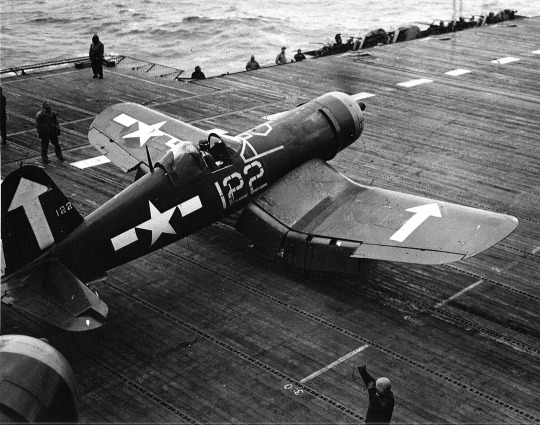
An F4U-1D of CVG-84 prepares to take off from USS Bunker Hill (CV-17), 6 May 1945
416 notes
·
View notes
Text

Black smoke pours from USS Bunker Hill (CV 17) after kamikaze aircraft hit the carrier during operations off Okinawa on 11 May 1945
73 notes
·
View notes
Text
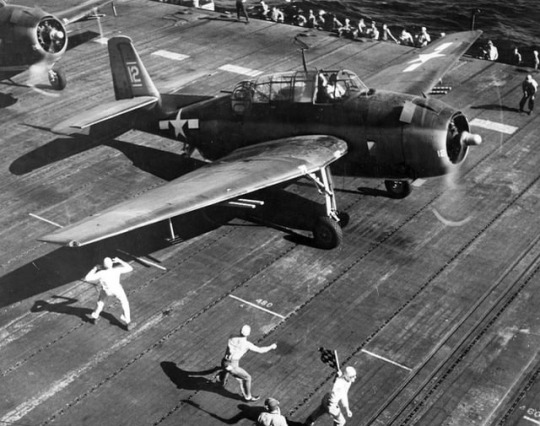
A U.S. Navy Grumman TBF Avenger of Torpedo Squadron VT-8 is poised for launch from the aircraft carrier USS Bunker Hill (CV-17), 10 June 1944
24 notes
·
View notes
Photo

“USS Bunker Hill (CV-17), painted in Ms. 32, Design 6A, passing astern of USS Wasp (CV-18), June 1944.”
(Source)
#Military#History#USS Bunker Hill#Aircraft carrier#United States Navy#US Navy#WWII#WW2#Pacific War#World War II
94 notes
·
View notes